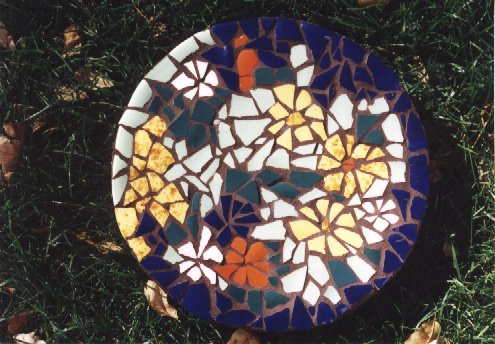
Creating Mosaics from Found Objects
The Pique Assiette ("Stolen Plate") Technique

Introduction:
The minute I opened a book on mosaics, I knew I wanted to work in this medium. I am not an artist (being a scientist with an artistic soul), but something about the nature of mosaic work called to me. I can't draw well, but I do enjoy working with color, composition and texture, and mosaic art provides a good outlet for such studies.
The problem I faced was this: almost every project in the book I was reading called for beautiful, regular, vitreous glass tiles, or tesserae. As I searched for these supplies, I found they were not readily available (except in Rome it seems), and were also expensive. Out of desperation, I did my first project with the technique the book referred to as "Pique Assiette," which uses broken crockery in place of purchased tesserae. It turned out well and I found the technique fun, creative and inexpensive. I've been smashing mugs ever since!
I have taught this technique in local community education classes many times, and this website features information I've assembled for my students. I have included many details based on experience because I've learned what things cause problems to beginners.
Enjoy yourself. Almost anything you do will turn out looking great!
Supplies:
Mosaic pieces-Collect old plates, cups and mugs from garage sales and thrift shops. Pieces with graphics and lettering can be used–just look for a variety of bright colors. You can also use other ‘found objects,' such as marbles, fake pearls, glass, shells, pebbles, etc., keeping in mind how the finished piece is going to be used. For example, exterior pieces need to be weatherproof, table tops need to be flat, etc. If you want flat pieces that are all the same thickness, buy new, discontinued or broken tiles at a tile store or home improvement store.
 |
Base–cement paving stones, plates, vases, candlesticks, mirrors, picture frames, etc.
 |
Should not be hurt by the moist adhesive and grout and must be sturdy enough to hold the weigh of ceramic, adhesive and grout. Wood needs to be finished and if intended for outdoor use, must be waterproofed (such as Marine grade plywood). Very shiny surfaces, such as glass, should be roughed up with sandpaper.
Round paving stones are available at building supply stores for about $2.38 each (if they have an aggregate surface, flip them over and use the other side). Terra cotta pieces (garden animals, etc.) are also easy to cover. Old vases can be obtained for $.50 or less at thrift stores. Your only concerns should be shape and type of surface–even the ugliest old plastic vase can look like a museum piece when it's been covered with colorful ceramic pieces. I have covered two old bowling balls to make unique "gazing balls" for the garden. People are very surprised when they try picking up the gazing ball and find it weighs 20 pounds!
Adhesive-look to match your base surface. I like a premixed mastic adhesive with a thick consistency which helps when using irregular pieces or curved bases.
Grout-comes in many colors–Dark grout better highlights the colors of the mosaic pieces. Sanded grout is better for large gaps but is rough. Unsanded grout (preferably with latex added) is much smoother and easier to work with on these projects.
Grout Sealer (if using finished product outside)
Tools-a putty knife for spreading adhesive, something to remove hardened adhesive, small rubber spatula for placing grout. You will need paper towels to clean and polish.
Technique:
1) Figure out a rough plan or drawing of what your finished piece should look like. Some hints:
2) Pick out the pieces of crockery you are going to use. Set the cups/plates/whatever together to see how they look.
3) Get out your hammer and smash the crockery pieces!
4) ‘Glue' the pieces on your surface
5) Wait 24 hours for the adhesive to set up
6) Grout
7) Wait at least 24 hours
Resources:
There are many new mosaic books on the market. All have good ideas, but many are somewhat limited, in that they feature a number of ‘craft' projects with detailed instructions on how to replicate them. I prefer books with lots of projects by artists: here are three inspiring ones:
Making Mosaics by Leslie Dierks, Sterling Publishing Company, Inc., 1997
Probably the most well-balanced book I've seen, teaching both traditional and pique assiette techniques. There are many pictures of unusual pieces created by mosaic artists around the world. Most of the actual projects provided with instructions, however, require traditional small glass tesserae.
Mosaics by Kaffe Fassett and Candace Bahouth, The Taunton Press, 1999
Both authors are noted for eclectic and extravagant works of art in many mediums. This book is a treasure chest of ideas, and focuses exclusively on the pique assiette technique, using such found objects as shells and stones in addition to all kinds of crockery, tiles, mirrors and beads. The choice of grout colors will destroy your old preconceptions of the purpose of grout! The book also contains a fascinating section of photographs of mosaic gardens, houses, chapels, fountains, etc. built by professional and amateur artists around the world as labors of love.
The Mosaic Book by Peggy Vance and Cecia Goodrick Clarke, Trafalger Square Publishing, 1994
This book contains instructions for traditional, pique assiette, and even cobblestone and pebble mosaics. There are many richly colored and textured designs, especially for the garden area.
View Examples of My Work: (please keep in mind that the colors are not necessarily accurately represented)
Please keep in mind that this site is intended to discuss the pique assiette technique only. If you are interested in learning more about traditional mosaic technique using regular tesserae of any type, there are many books which can help you (including Making Mosaics and The Mosaic Book mentioned in the "Resources" section).
Have fun creating beautiful and functional MOSAIC art!
Teresa Anderson, St. Paul, Minnesota, April 2000